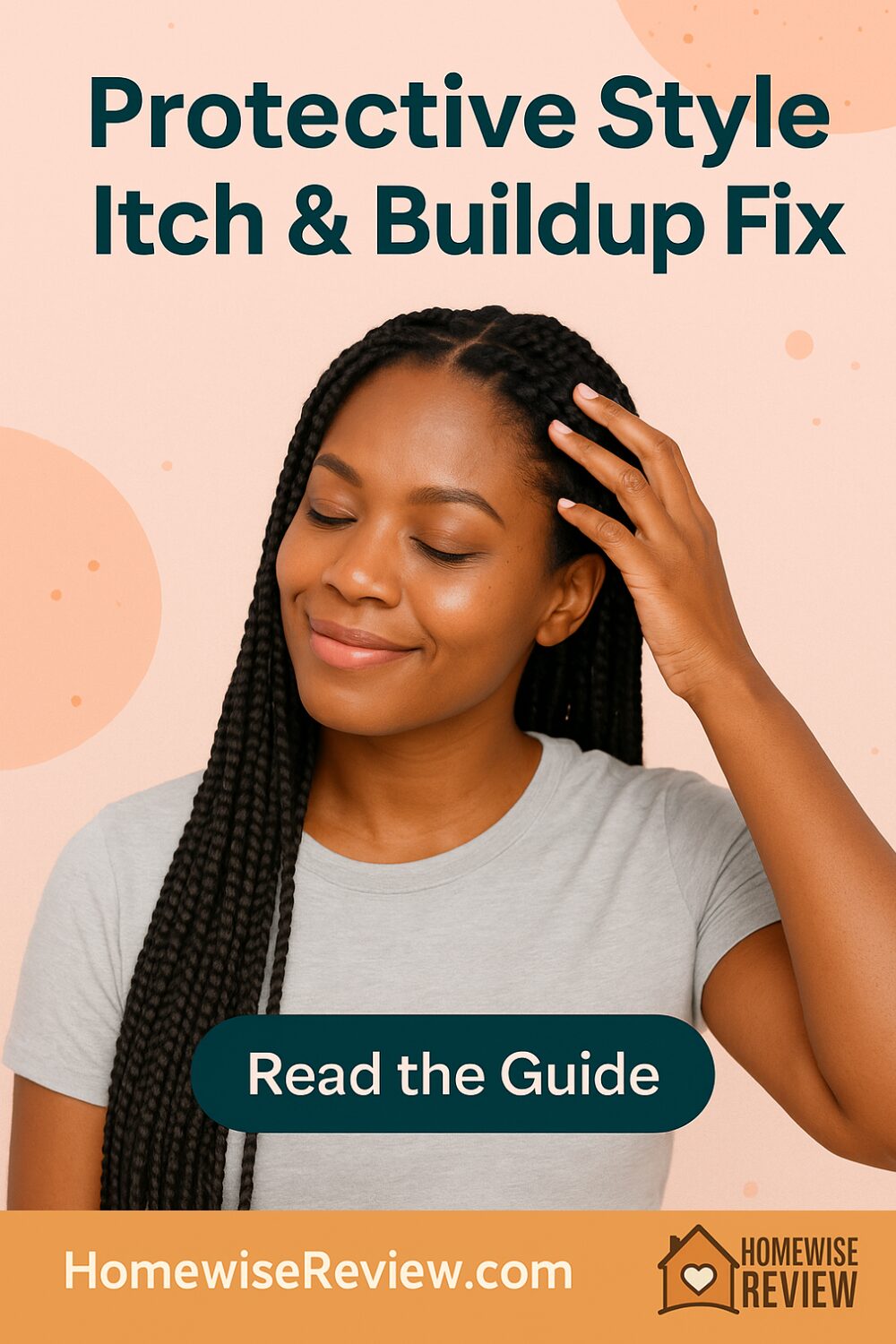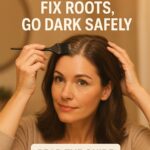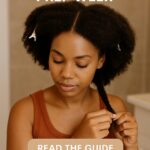
Protective styles are supposed to give your hair a break. Less heat, less daily manipulation, less stress on fragile ends. The problem is what happens under the style. By day three you are scratching in public. By week two your scalp feels tight, shiny, and angry. By week three you are scared to touch your edges because they feel thin and sore.
This guide is for that middle period. Not the install day glow, not takedown day. The uncomfortable middle where you’re trying to make it to the four to six week mark without flakes, odor, tenderness along your hairline, or breakage that sets you back.
We are going to walk through why protective styles itch, how to calm your scalp without ruining the style, how to manage buildup and odor in a way that will not cause frizz, and how to protect your edges so you still have a hairline when you take it down. We will also talk about when it is time to stop pushing it and just remove the style. You will see references to other guides throughout. Those are there so you can go deeper on the exact situation you are dealing with, like braids that sting or wigs that rub.
Why Protective Styles Can Itch So Fast
Most people assume itch always means “dirty.” Sometimes yes. A lot of the time it’s actually tension, trapped sweat, and product reacting with your scalp.
Braids, sew-ins and silk press rest weeks all create a warmer, less ventilated environment at the scalp. Your scalp is skin. Skin trapped under hair, wrap caps, glue, spray, edge control and oil will get warm and damp. Warm and damp skin gets irritated easily. That irritation shows up as itch, tightness across parts, and sometimes tiny bumps around the hairline.
There is also tension. If a braid, track, or wig is too tight, blood flow to that area is reduced and the skin will feel hot, sore or itchy. Scratching doesn’t fix that. It actually adds inflammation on top of tension. Long term that’s how you thin the front inch of your hair.
Then there is buildup. Edge gels, holding sprays, dry shampoo, lace glue, scalp oil. All of that sits on your scalp while the hair itself is tucked away. You’re not rinsing daily. You’re probably sweating at night under a scarf or bonnet. That creates a film. The longer the film sits, the more it can clog follicles and trap odor.
So the itch you feel after a couple of days in braids or a sew-in is usually a mix of three things at once. Light irritation from sweat, residue sitting on your scalp, and tension. This is why a fix has to be gentle and layered, not just “oil it” or “wash it.”
Calming Scalp Itch Under Braids Without Ruining the Install
The goal here is comfort without frizzing up the style you paid for. This is where a lot of people go wrong and overdo it with heavy oils or aggressive washing that lifts new braids and causes fuzz.
Start with cooling, not scratching. A targeted soothing mist on the scalp lines can calm that hot, tight feeling without you digging in with your nails. Look for lightweight water based sprays with ingredients made for irritated scalp, not thick hair grease. This is the same approach covered in Itchy Scalp Under Braids: Quick Relief Tips, which focuses on fast itch relief for tight or dry installs without instantly aging the style.
Next, deal with buildup in the part lines. If you see white film or you can feel waxy residue with your fingertip, that is buildup sitting on your scalp. That buildup traps heat and makes itch feel worse. A gentle scalp cleanser that is applied with a nozzle directly between rows can help lift residue without soaking the whole style. You’re not doing a full shampoo session in the sink. You’re spot treating.
If you have visible flaking or you can smell stale sweat when you move your hair, you are past “just itch.” You’re in early buildup. This is where a scalp scrub designed for protective styles can help. Best Scalp Scrubs for Build Up on Natural Hair talks through options that break down residue and product film without ripping at your roots. Key point. You want something with fine exfoliation and slip, not gritty salt that will snag new braids.
Finally, watch for any area that feels hot, swollen, or painful when you press on it. Constant itch plus heat is a red flag. That means tension or irritation that is bordering on damage. No cute style is worth traction alopecia. If one braid or track is doing that, you loosen or remove that section. You do not wait it out.
Managing Buildup and Odor When Your Hair Is Tucked Away
Buildup is not just about looks. It chokes the scalp, blocks follicles, and can slow growth. If your plan is “protective style to retain length,” you have to keep the scalp breathable during the wear, not just on takedown day.
Think of maintenance in three zones.
Zone one is the scalp itself. This is the base that needs to stay clear. Light cleansing in the parts, targeted rinsing with a squeeze bottle, and pat-drying with a towel or T-shirt can keep odor down without frizzing braids or loosening a sew-in. The Scalp Care Under Wigs Keep Growth Going guide goes into detail on how to keep the scalp calm and clean under wigs so you do not undo any growth you’re trying to protect.
Zone two is the leave out, edges, and nape. If you’re wearing a sew-in, U-part, quick weave or wig with leave out, that exposed hair is going to get heat, edge control, and touching. It needs moisture and slip or it will snap. A light cream polish like the type discussed in Oribe Supershine Moisturizing Creme Review can smooth fried or over flat ironed ends so they bend instead of crack. This matters on silk press rest weeks too, where the goal is to keep hair smooth without drowning it in oil that will weigh it down and collect dust.
Zone three is your mid-lengths and ends once you’re in “rest week” mode after a silk press or blowout. You might not be doing a full twist out or braid out. You might just be wrapping at night and trying not to touch it. This is a good moment to work in slip without buildup. Slip Without Build Up: Detangling Game Plan for Coils talks about how to get smooth detangling and soft separation without piling on products that crust or flake. The idea is that protection is not just low manipulation. It is low friction. Less scraping and snagging every time you move.
One more note on smell under wigs. If you get a sour smell after two or three days in the same unit, that is sweat and product trapped at the cap line. You can wipe along that line with a damp cloth and a little diluted shampoo, then dry it with cool air. Do not spray perfume on your wig cap. That is skin. Fragrance plus sweat can make irritation worse.
Protecting Edges, Nape, and Part Lines During a Long Wear Style
Edges and the nape are usually what break first. The front inch of hairline is already the most fragile hair on most people. Now layer on tension from braids, gel crust from daily swoops, a wig band rubbing in the same spot, and scarves tied too tight at night. You get thinning and shiny skin patches where the hair should be.
Two big rules here.
Rule one. If it hurts, it’s too tight. A protective style should never feel like a constant headache behind your ears or along your forehead. That constant pull can cause permanent thinning. Edge Care Routine for Protective Styles: reduce tension and thinning covers how to create a buffer between tension points and your actual follicles, especially around the temples and sideburn area. The basic idea is pressure management. Loosen or redo anything that is pulling hard. Use a softer tie at night. Do not keep slicking the same inch of hair every morning.
Rule two. Keep friction down at night. Cotton pillowcases, rough scarf fabric, or a wig band digging into the same point all night will rub those short hairs until they snap. A smooth wrap or bonnet can help, but only if it’s not pulling. If you wake up with a line across your forehead where your scarf sat, it’s too tight. You are trading tension for protection.
Also pay attention to product layering. Edge control on top of yesterday’s edge control will look sleek, but it’s building a rigid shell. That shell dries the fine hair at the hairline and can block the follicle. Over time that is how breakage becomes thinning. Work with a softer hold on off days, or rinse the area gently before reapplying. You want flexibility, not a helmet.
Finally, detangling after you take hair down is just as important as the wear period. If all your shed hair is trapped in braids, it’s going to clump at takedown. That’s normal. The danger is yanking through those clumps in a rush. You want slip, patience, and sections so you’re not ripping fragile roots. Slip Without Build Up: Detangling Game Plan for Coils is built around that exact moment and is worth reading before takedown so you do not panic and tear through knots.
When To Take the Style Down and Reset
A protective style is only protective if your scalp is still healthy under it. There are clear “take it down” signs.
If you have persistent burning, not just a little itch when you get warm, that style is too tight or the products used are irritating your skin. That should come out.
If your scalp is developing scabs, bumps with pus, or areas that feel hot and raised, that can be early follicle inflammation. You do not wait weeks on that. You remove the tension and let the area breathe. If you notice actual open areas or spreading redness, you talk to a professional because that can turn into infection if ignored.
If odor stays even after gentle spot cleansing of the scalp lines, you probably have sweat and product trapped under the base of the style. At that point, you’re not in “refresh and push it longer” territory. You’re in “wash properly” territory, which means removing the install.
Once you take hair down, your next job is recovery, not style number two in the same day. Scalp Care Under Wigs Keep Growth Going walks through how to keep scalp comfort and growth momentum when you’re wearing wigs or other low manipulation coverage instead of tight braids. The point is to build in rest weeks with low tension and moisture, not jump straight from one high tension style to the next.
After removal, focus on four things before you reinstall. Gentle cleanse to clear sweat, glue, gel and dry shampoo. Deep moisture to soften the line of demarcation where new growth meets older ends. Light protein if breakage at the ends is getting obvious. And edge rehab. That means babying your front hairline, not slicking it and pretending it’s fine. If you keep cycling installs without that reset, thinning will sneak up fast.
Final Thoughts
Protective styles can absolutely help you keep length, protect ends, and survive busy weeks without daily heat. They can also quietly destroy your edges, clog your scalp and make you miserable if you treat them like a set it and forget it situation.
The sweet spot is comfort plus maintenance. Keep the scalp calm and breathable, keep tension low, keep friction down at night, and do not ignore warning signs like burning or shiny thinning areas at the hairline. Build in true rest weeks instead of back to back installs.
If you treat protective styling like part of an ongoing hair care cycle, not a break from hair care, you keep the growth you’re working for.
See also
If your scalp starts to prickle, tighten or sting a few days into braids, go read Itchy Scalp Under Braids: Quick Relief Tips for fast comfort moves that do not fuzz up new braids. If you are noticing waxy buildup in parts, or that stale sweaty smell under a wig or sew-in, bookmark Best Scalp Scrubs for Build Up on Natural Hair so you know how to lift residue without tearing at your roots. Detangling after takedown is where a ton of breakage happens, so walk through Slip Without Build Up: Detangling Game Plan for Coils before you reach for a comb.
Longer term, healthy protective styling is about keeping growth going under coverage and not letting tension eat your edges. Scalp Care Under Wigs Keep Growth Going shows how to keep the scalp breathable during wig weeks instead of smothered under glue and spray. For hairline safety, temple soreness, or that pulled feeling around your forehead, study Edge Care Routine for Protective Styles: reduce tension and thinning and start treating your edges like something you plan to keep.
FAQs
How long can I keep a protective style in before it starts hurting my scalp health?
For most people, four weeks is the comfort window. Past that, sweat, edge control, dry shampoo, and glue start layering on your scalp in a way you cannot fully clean without removing the style. You also start to get tension on new growth because as your hair grows out, the base of each braid or track sits farther from the scalp and pulls more. If you are getting burning, bumps, or sore spots before week four, that is already too long for that install.
Should I oil my scalp under braids or a sew-in to stop itching?
Lightweight soothing sprays are usually better than heavy oil. Thick oil can feel good in the moment, but it mixes with sweat and product and creates a film. That film traps heat and can clog follicles. If you are very dry or flaky, you can use a light targeted scalp oil in the part lines, but it should absorb, not sit there shiny and sticky. If oiling only calms things for a few hours and the itch comes right back, you are probably dealing with tension, not dryness.
Why does my sew-in or quick weave itch on day two even if it is brand new?
That early itch is almost always tension plus trapped sweat under a tight base. The braids underneath are snug, the tracks are sewn or glued in, and air is not circulating. Your scalp gets warm and irritated. Do not scratch hard with your nails or a pointed object. That can break skin under the track where you cannot see it. Instead, gently tap or press, and use a light cooling scalp spray between the rows to take down that hot tight feeling.
Can I wash my silk press during a “rest week” or I will ruin it?
A silk press rest week is about low manipulation and low heat, not zero cleansing. You do want to avoid a full drench if you are trying to keep the press smooth, but you can wipe your scalp lines with a damp cloth and a small amount of diluted shampoo, then dry with cool air. Focus on the scalp instead of soaking the lengths. If your scalp feels sweaty, itchy, or has mild odor, a light targeted cleanse is better than letting buildup sit and irritate your roots.
How do I sleep without rubbing out my edges or making my wig line sore?
Two things matter at night. Fabric and pressure. A smooth bonnet or wrap helps reduce friction, but it should not be tight enough to leave a line on your forehead in the morning. If your wig band is digging into the same spot every night, adjust it or switch to a softer band while you sleep. Also, avoid tying scarves directly on the most fragile hairs at your temples. Shift the knot or band slightly farther back so you are not sawing at the same inch of hairline every night.
Affiliate Disclosure
If you purchase through links on our site, we may earn a small commission at no extra cost to you.




